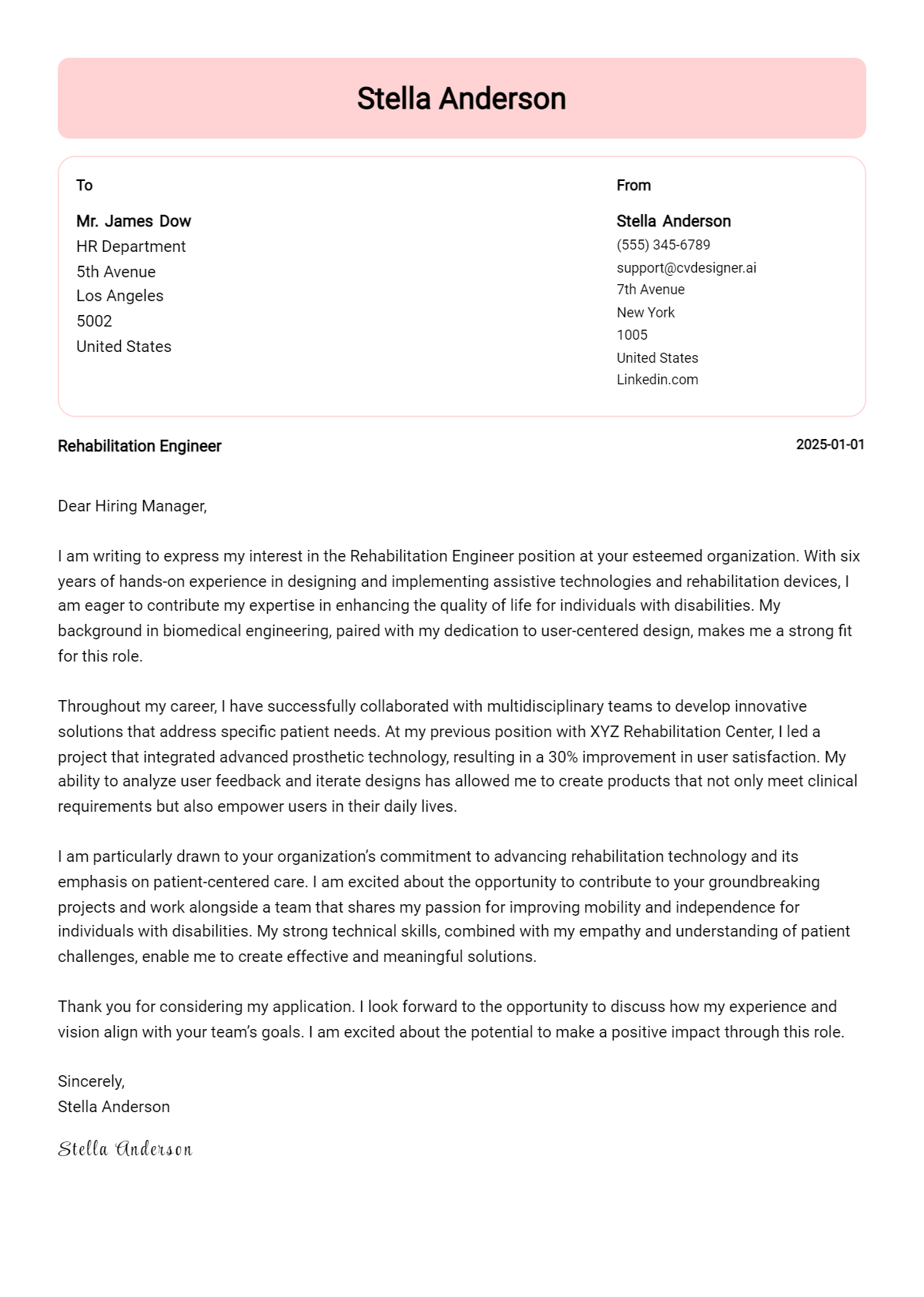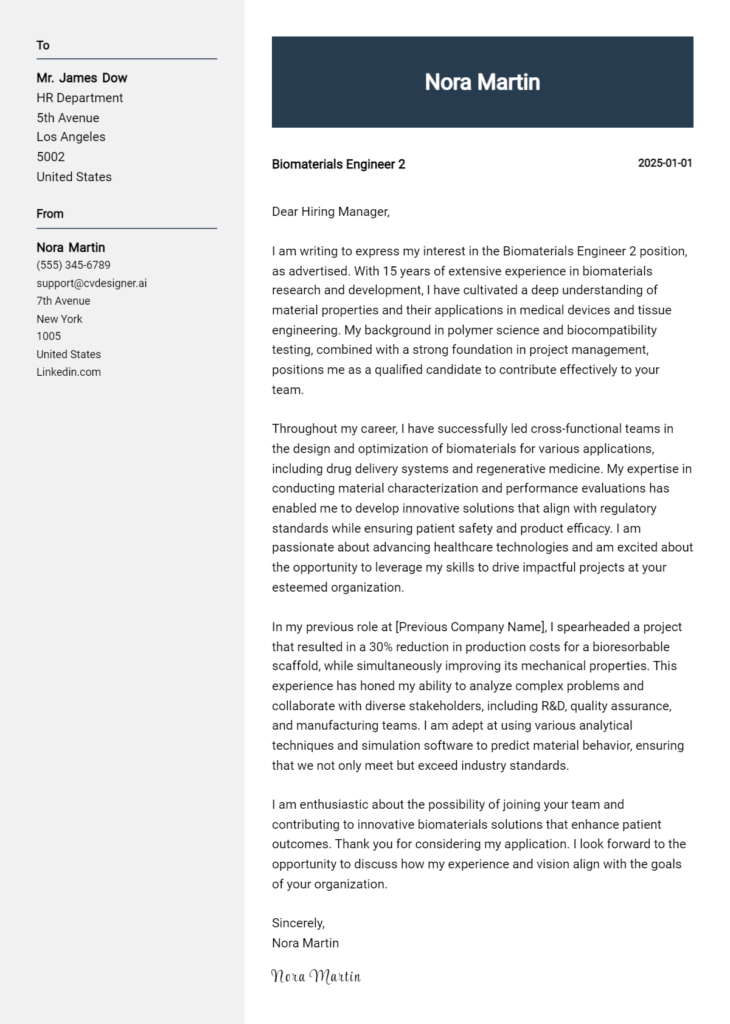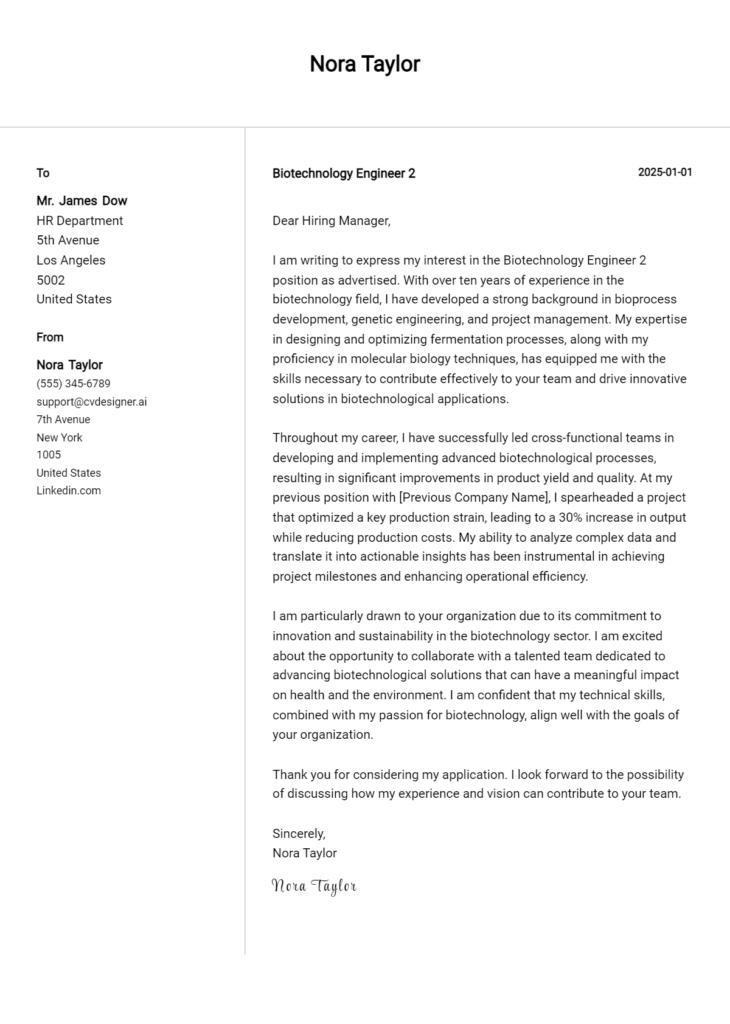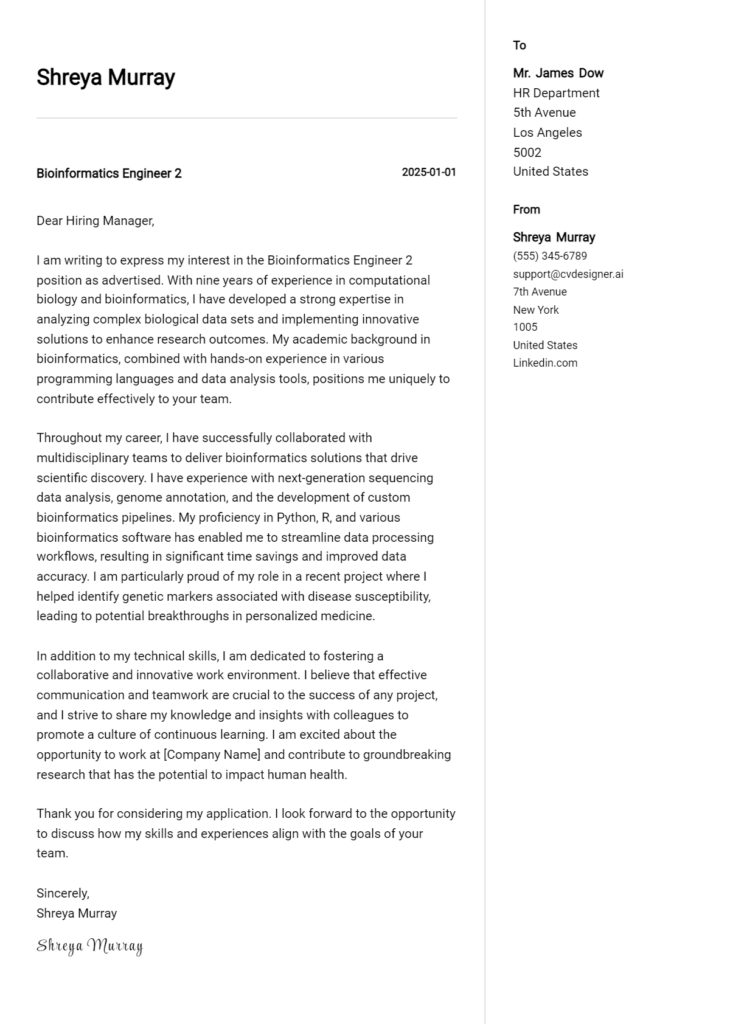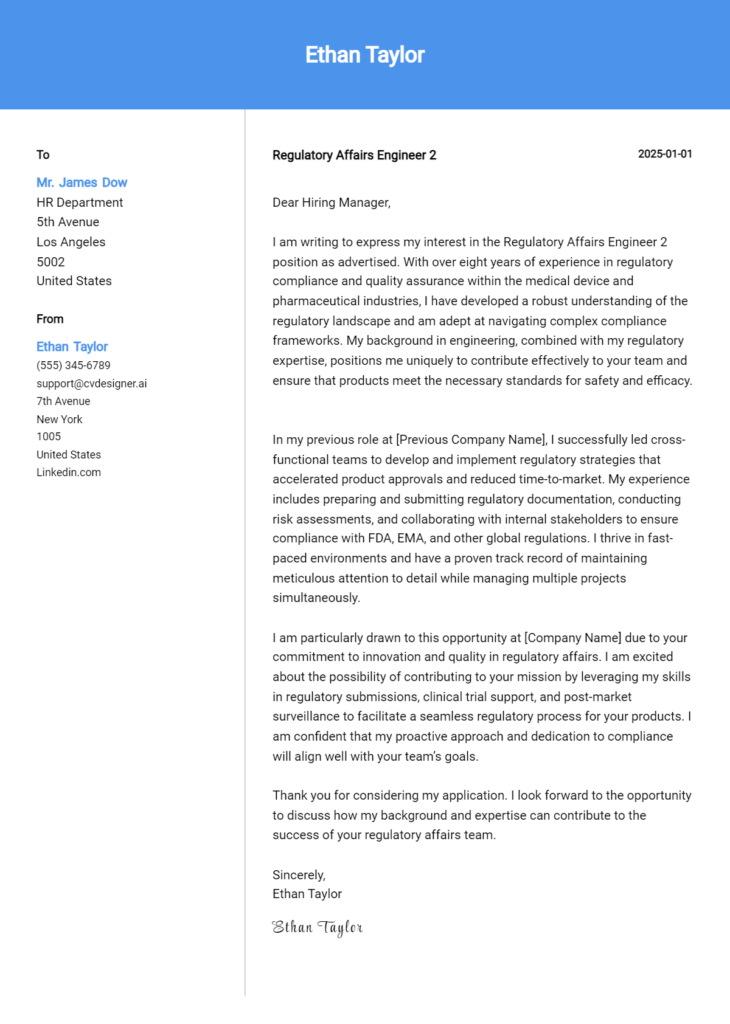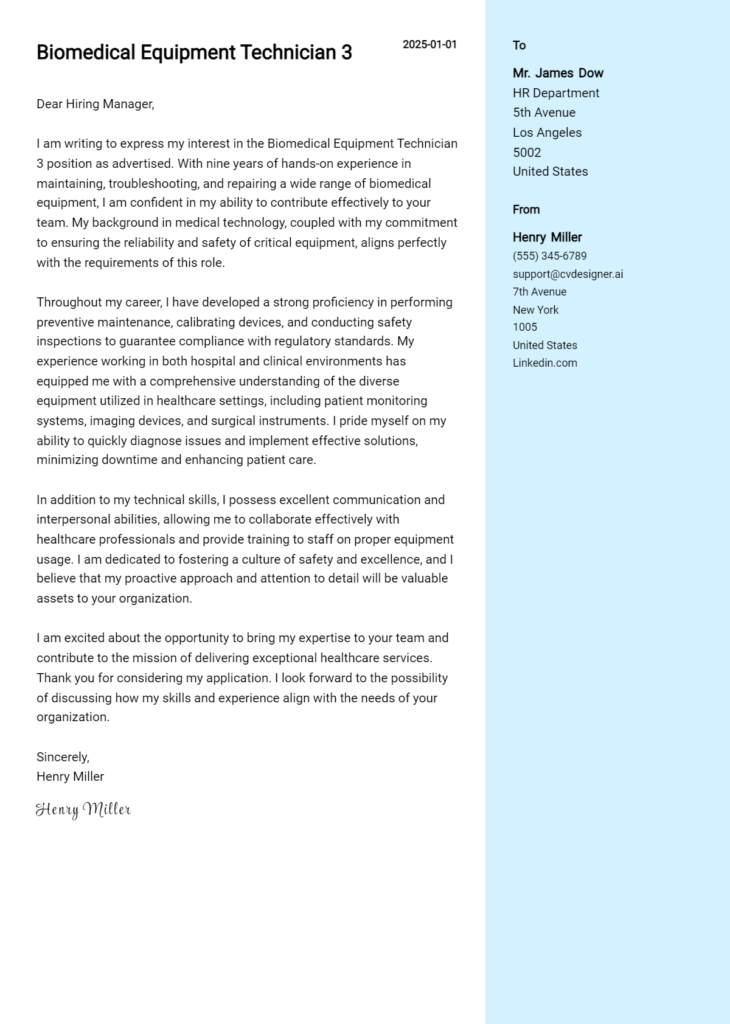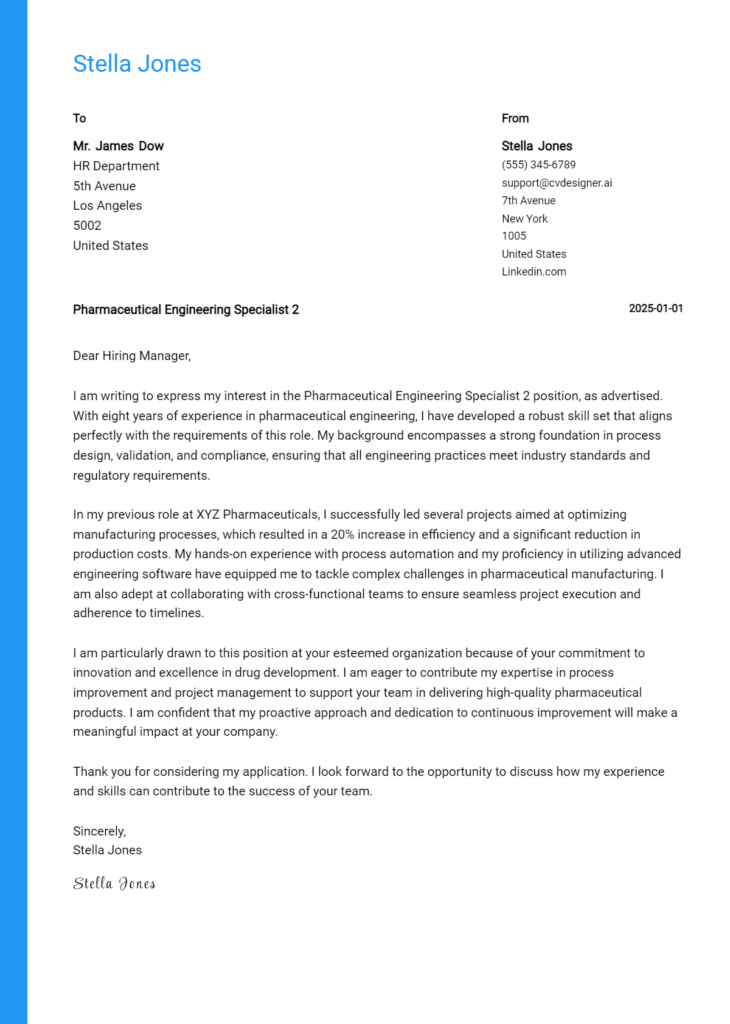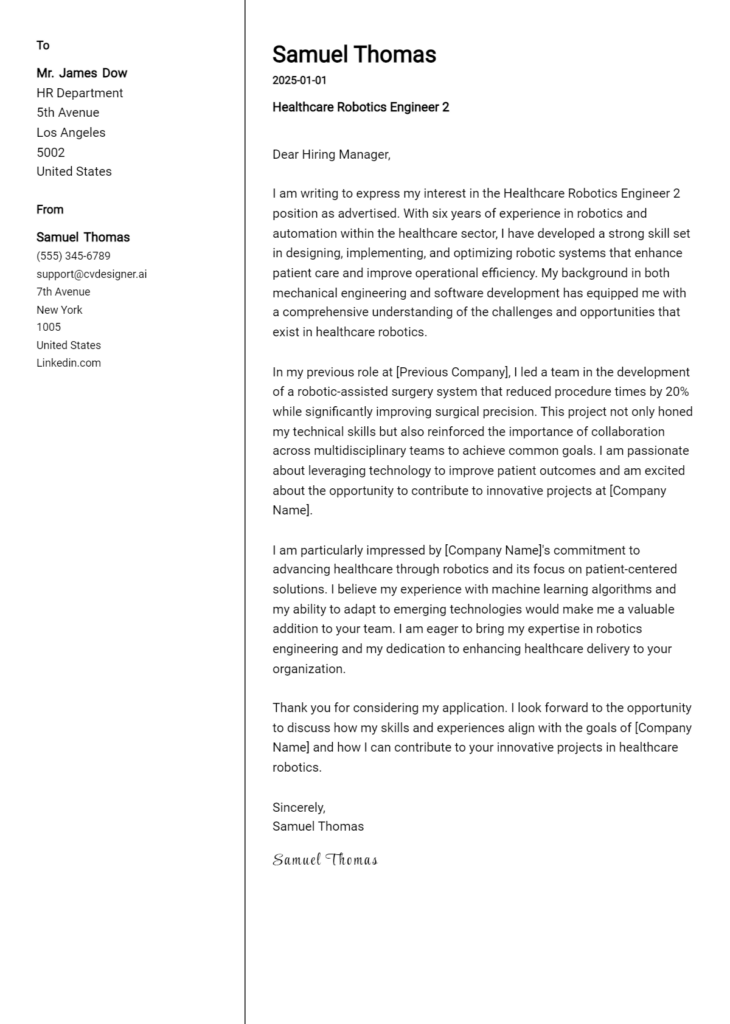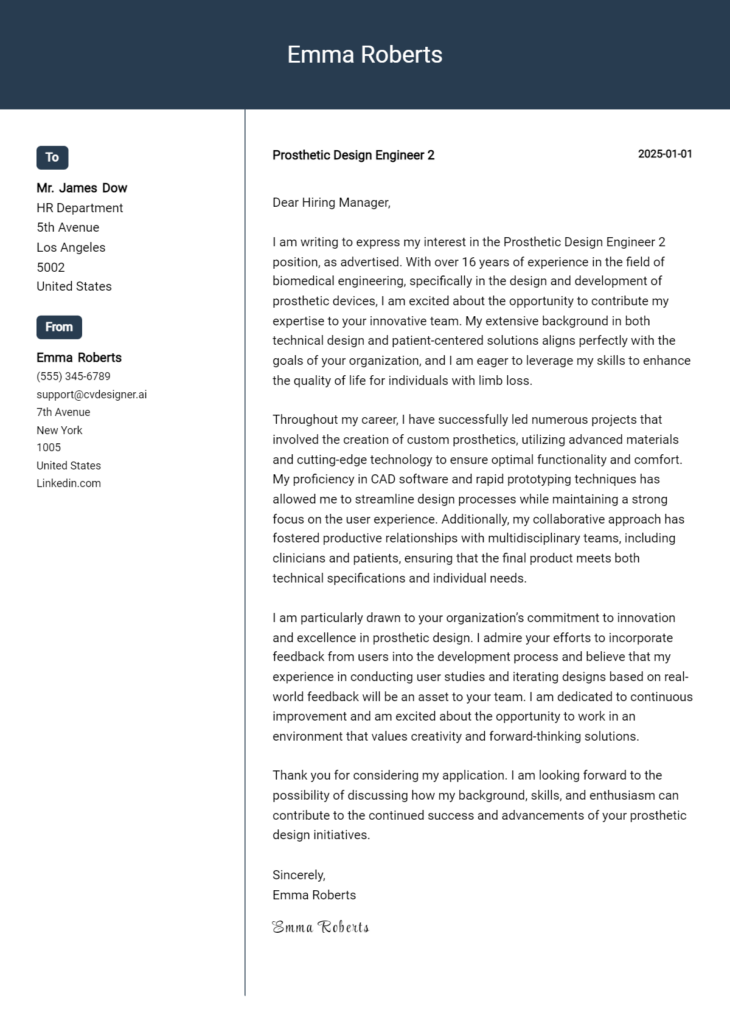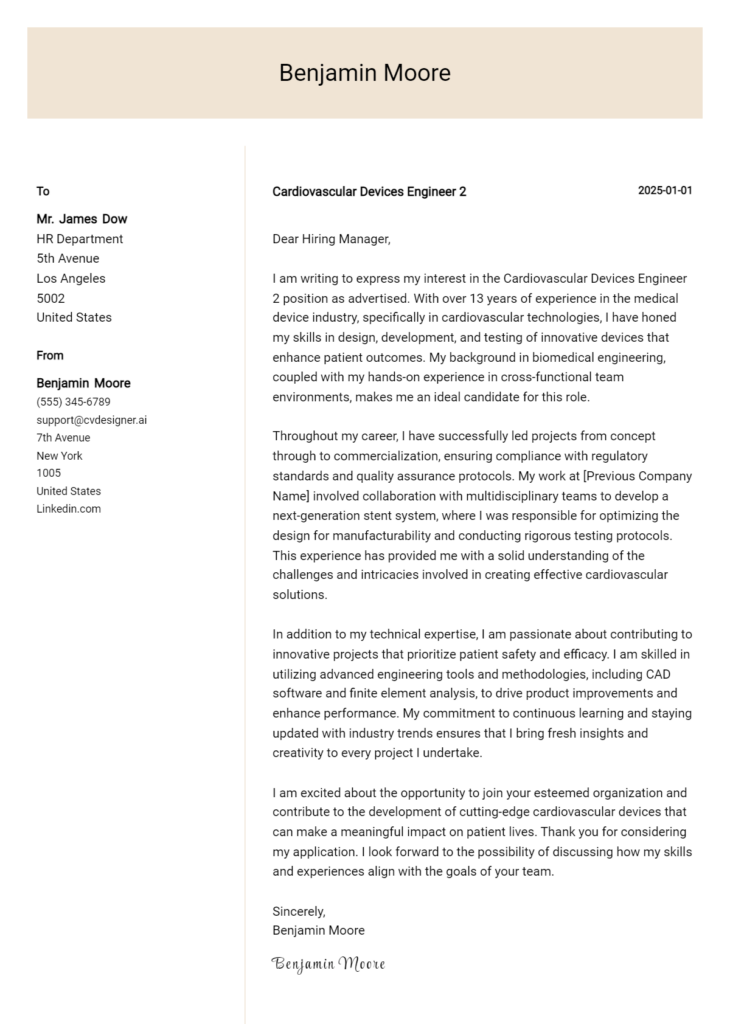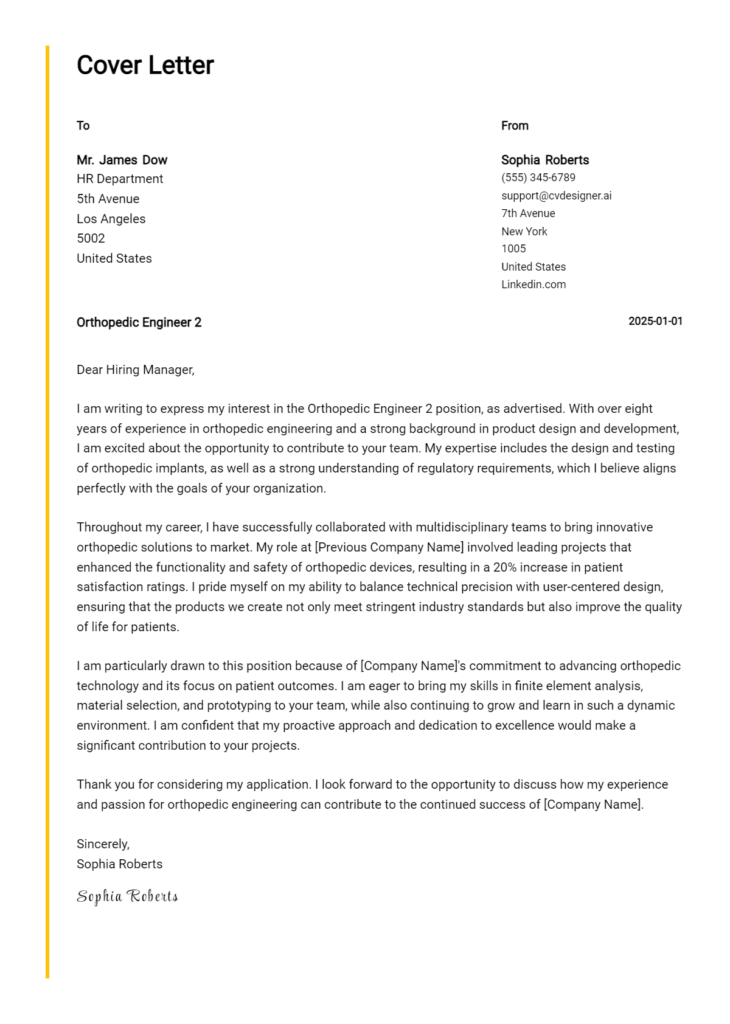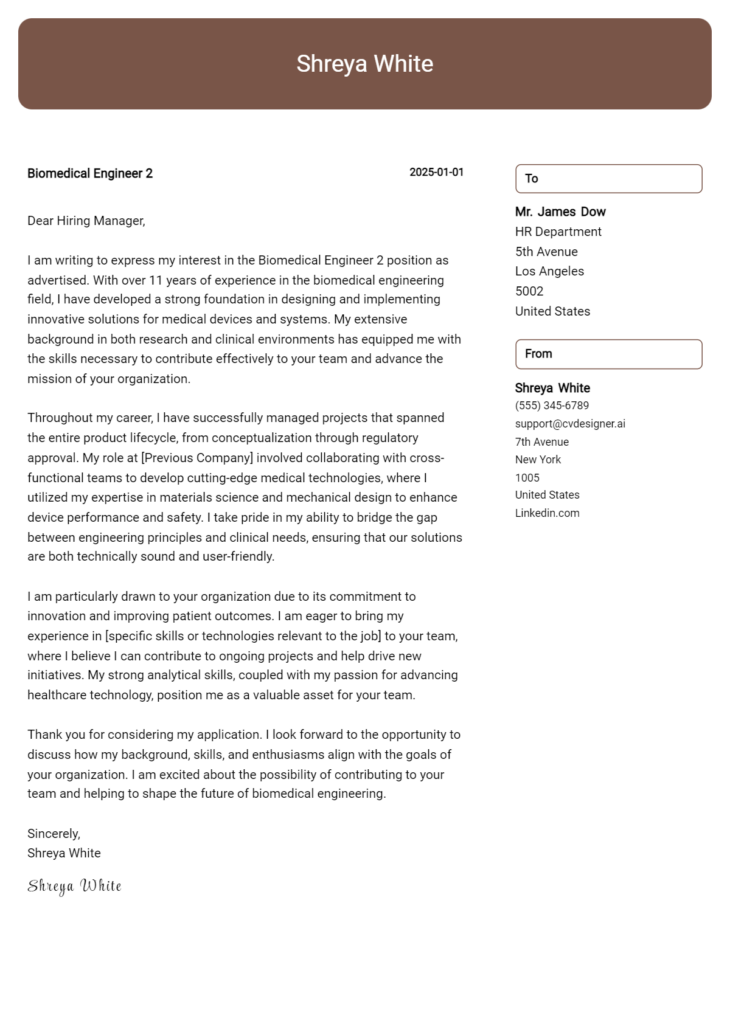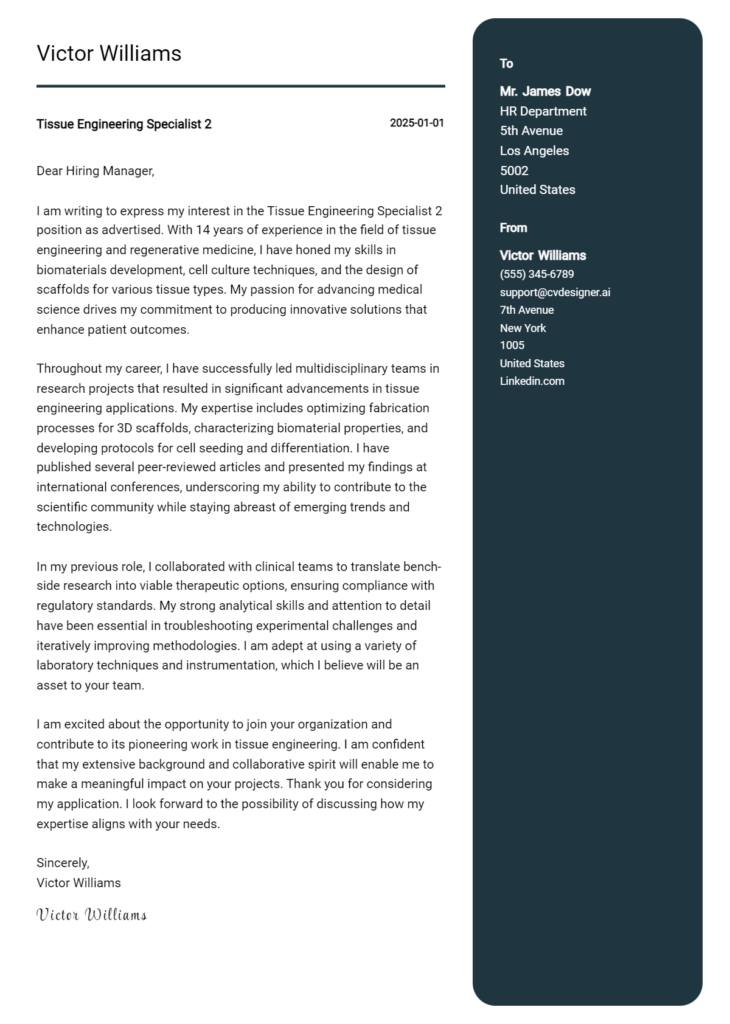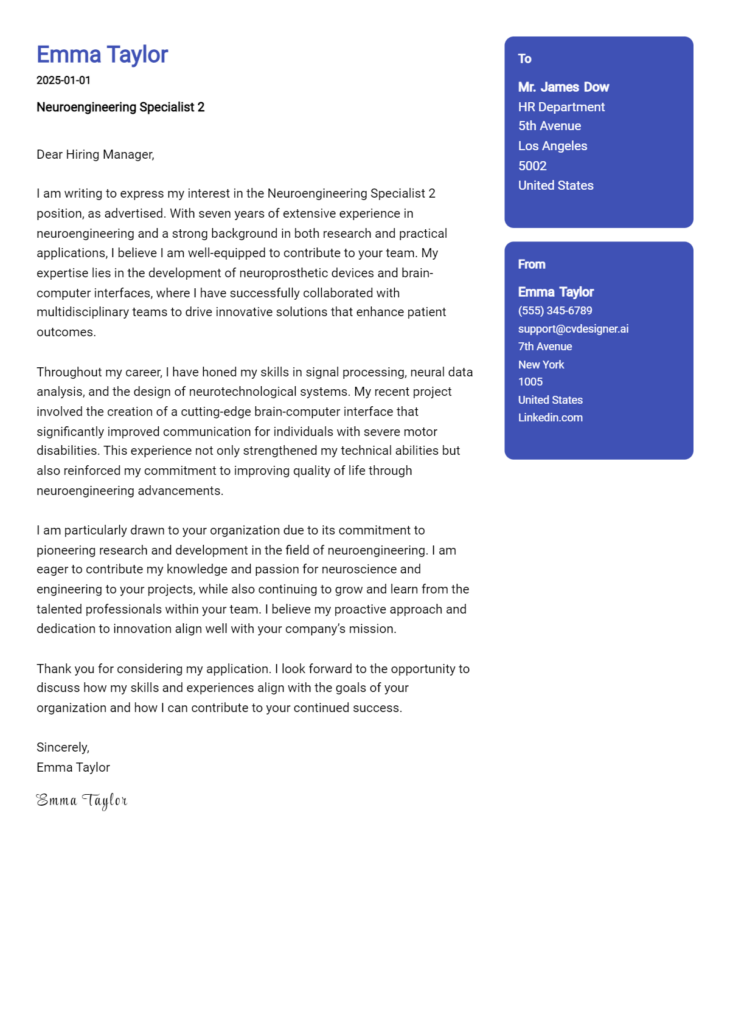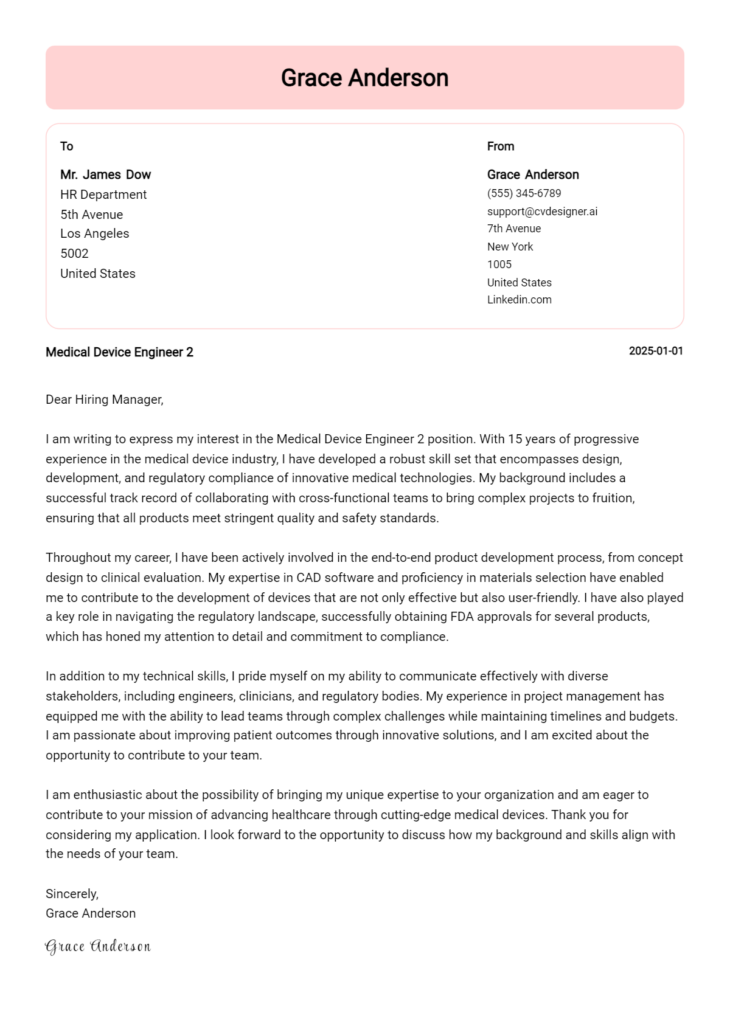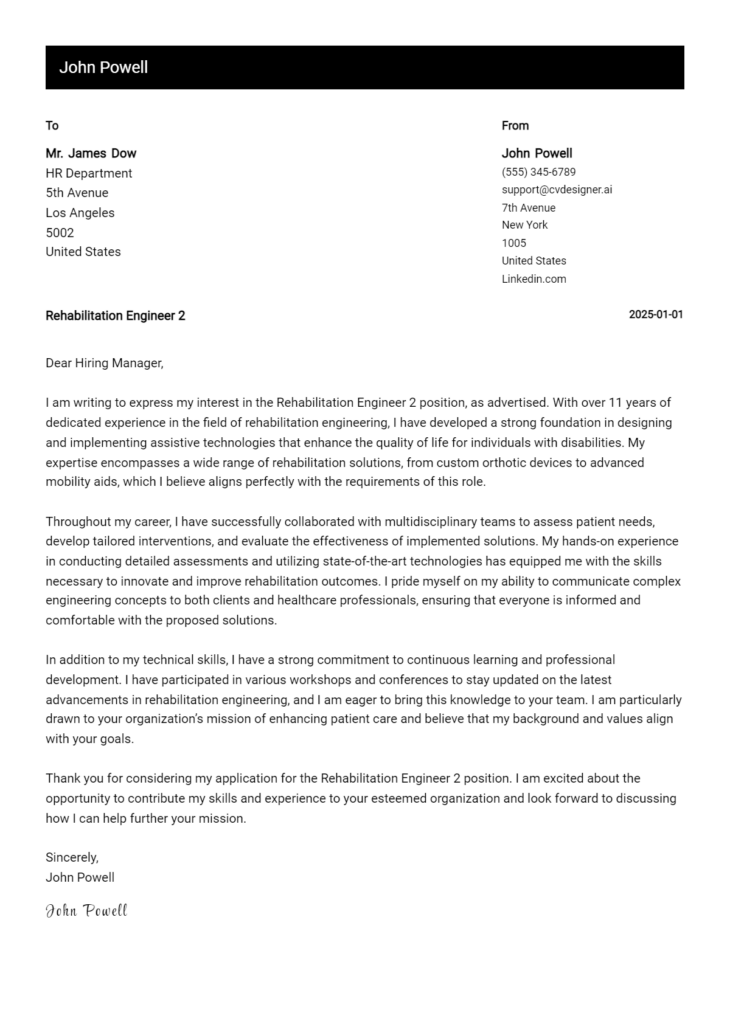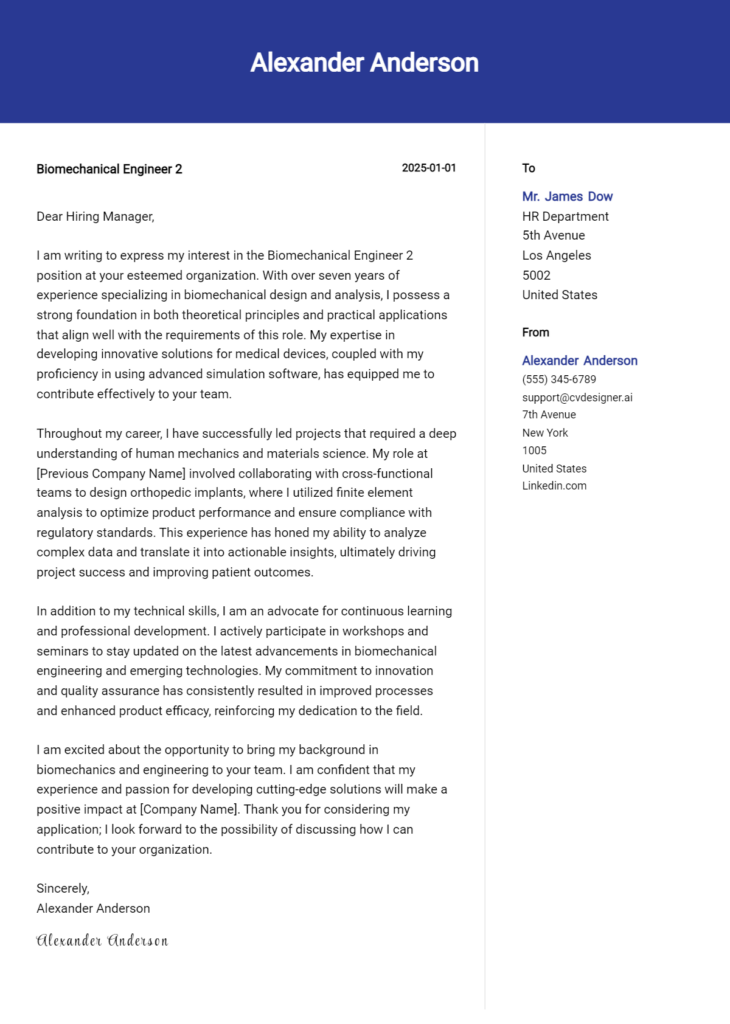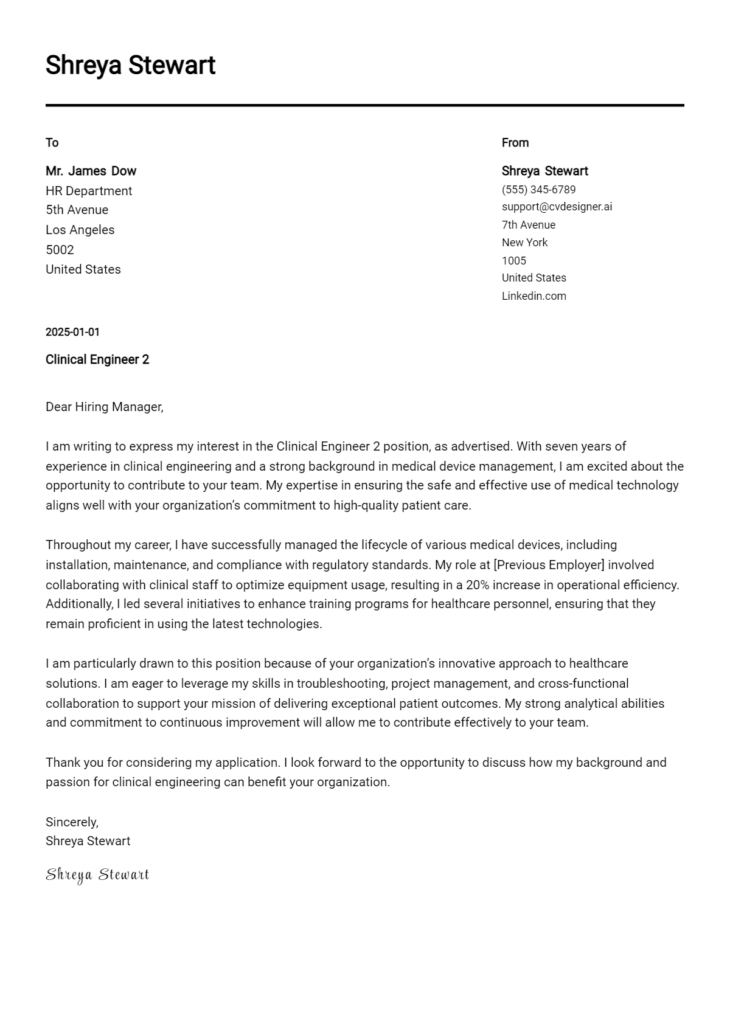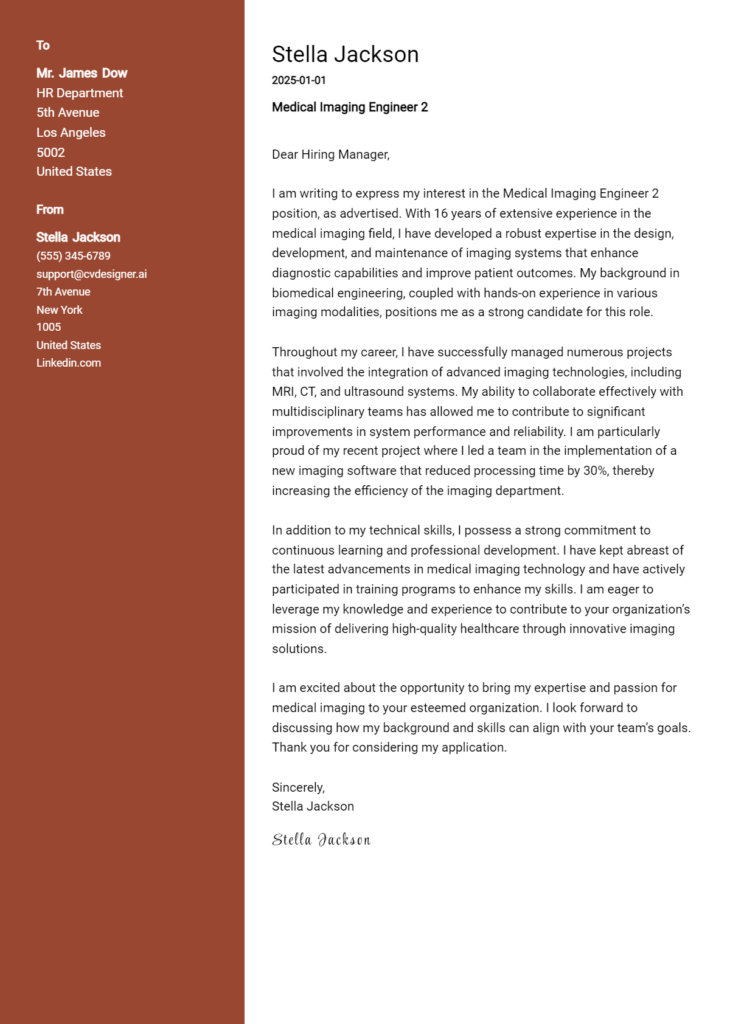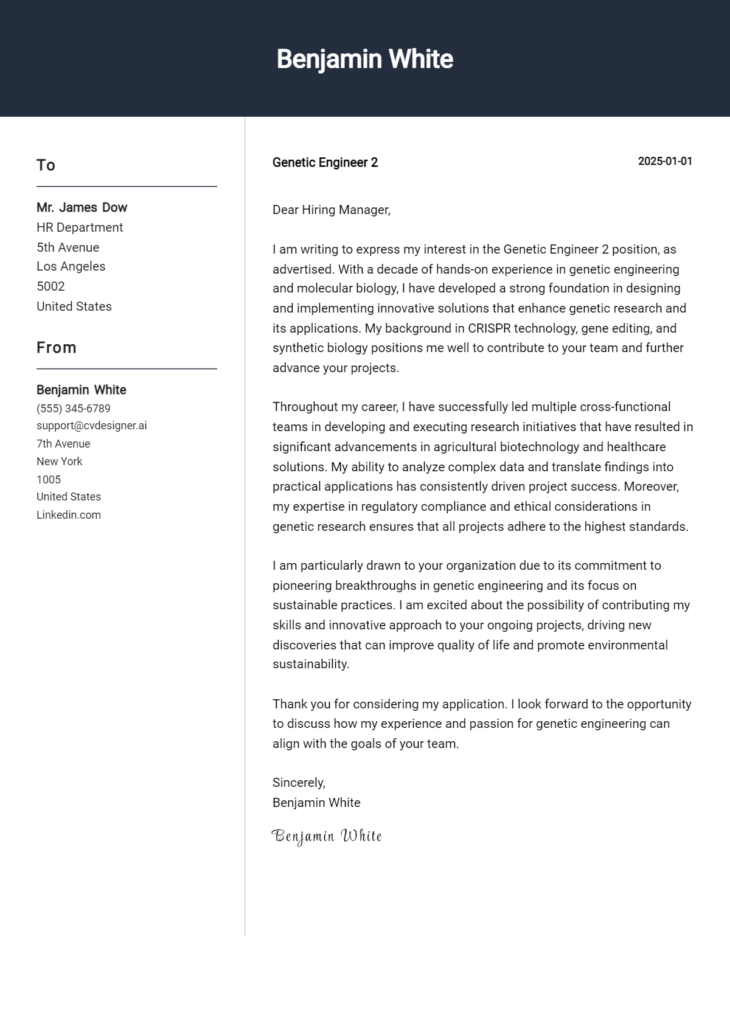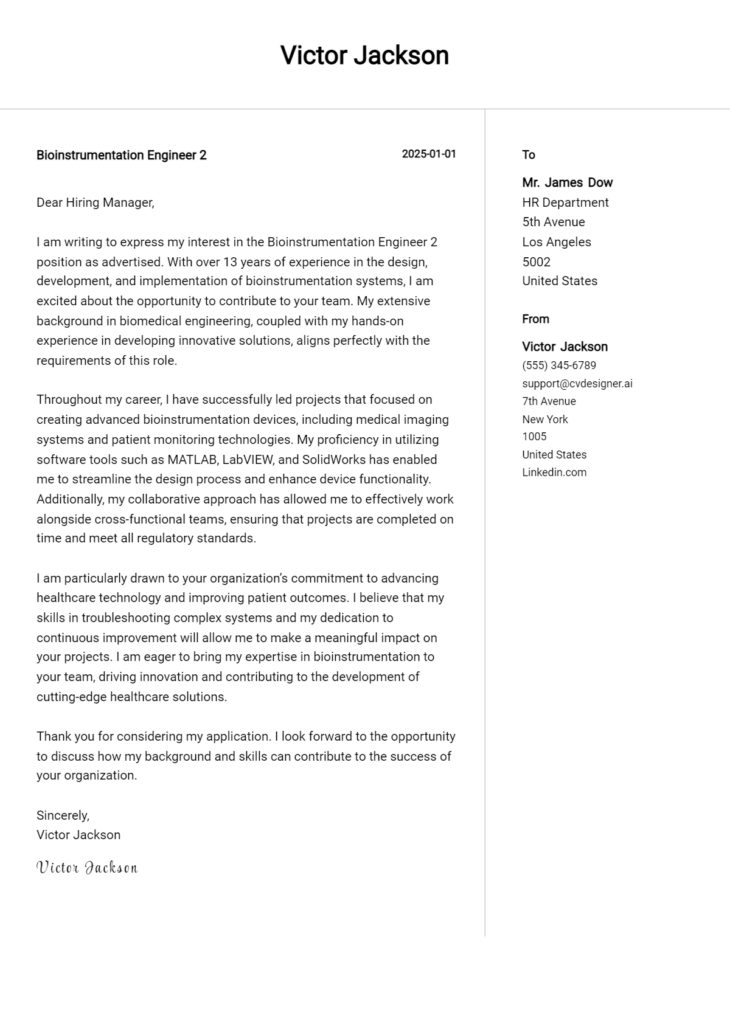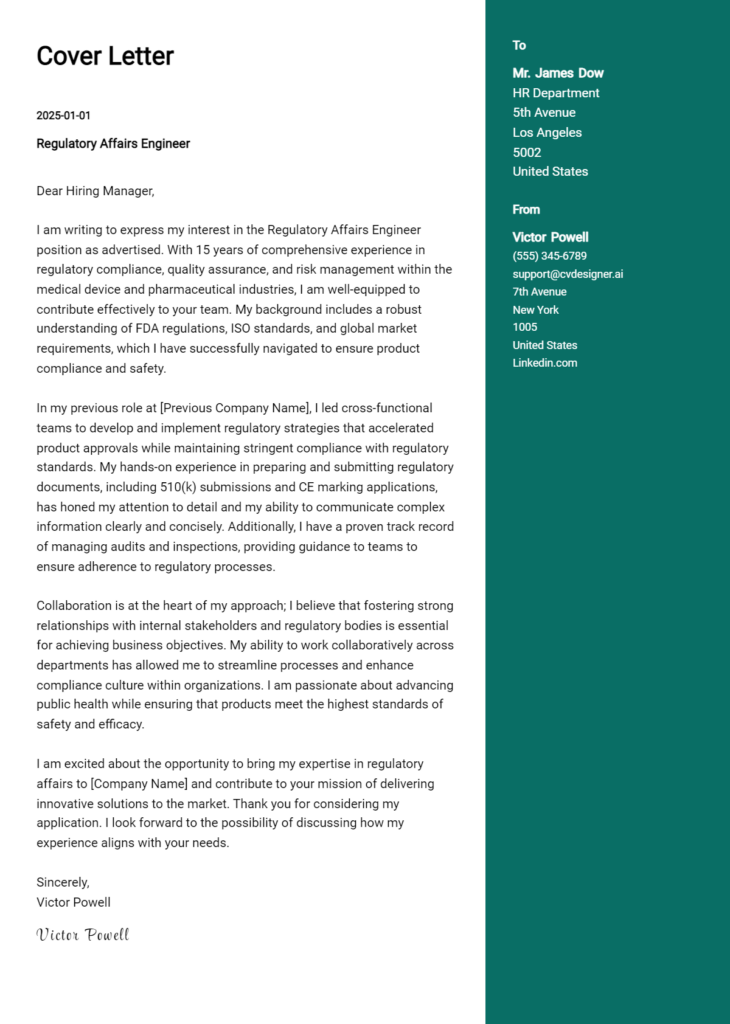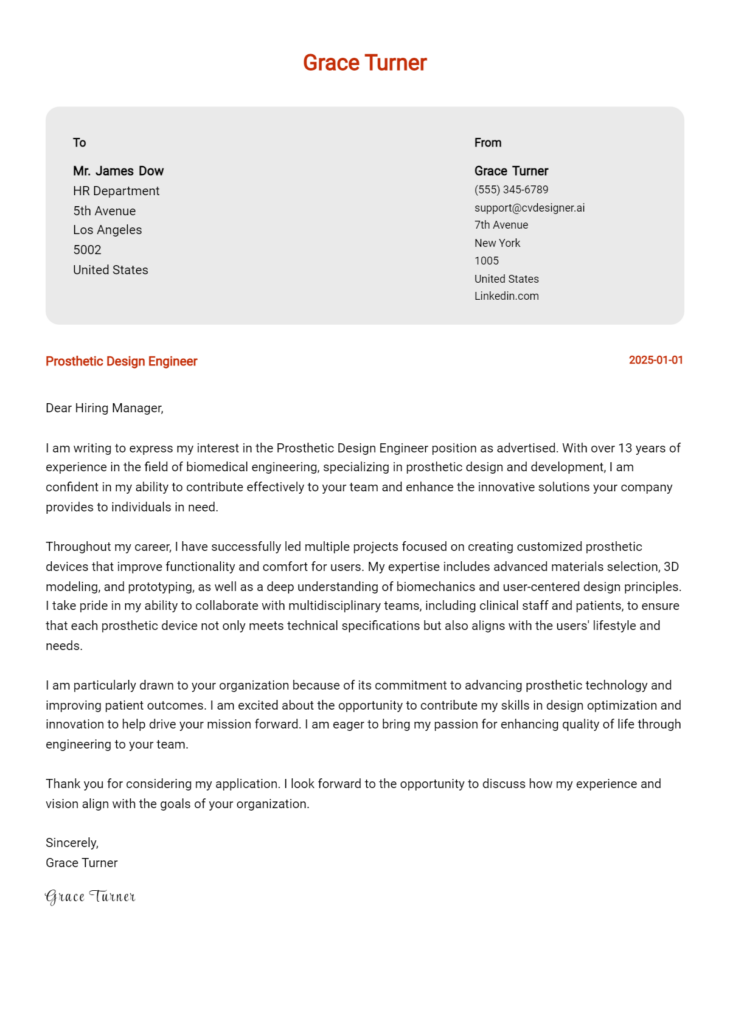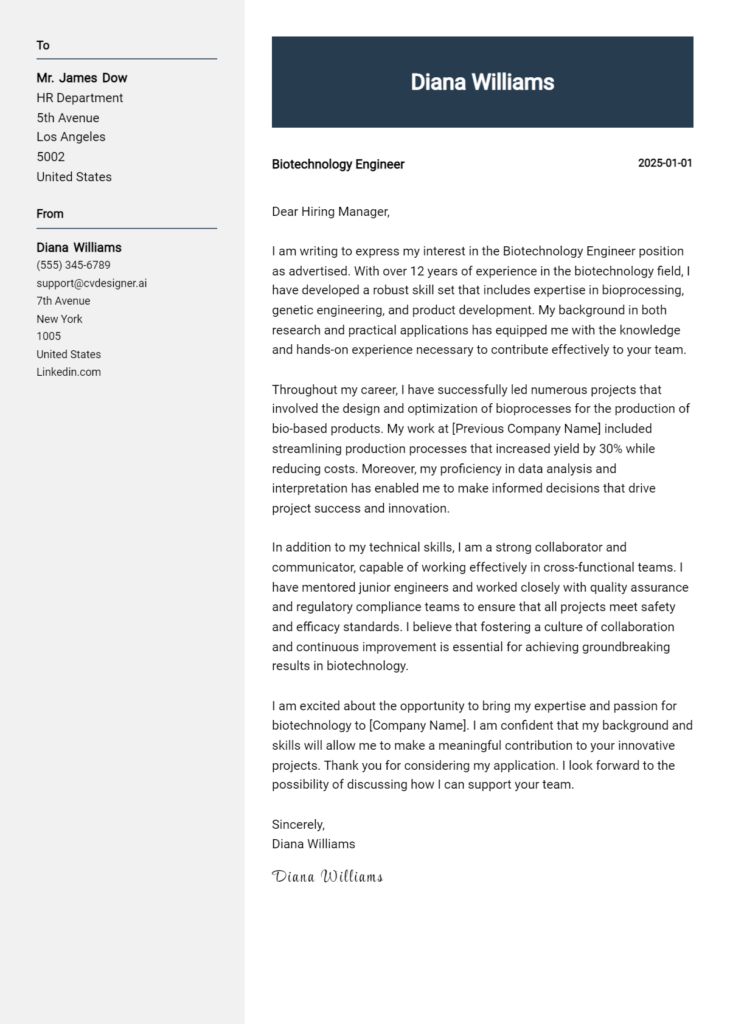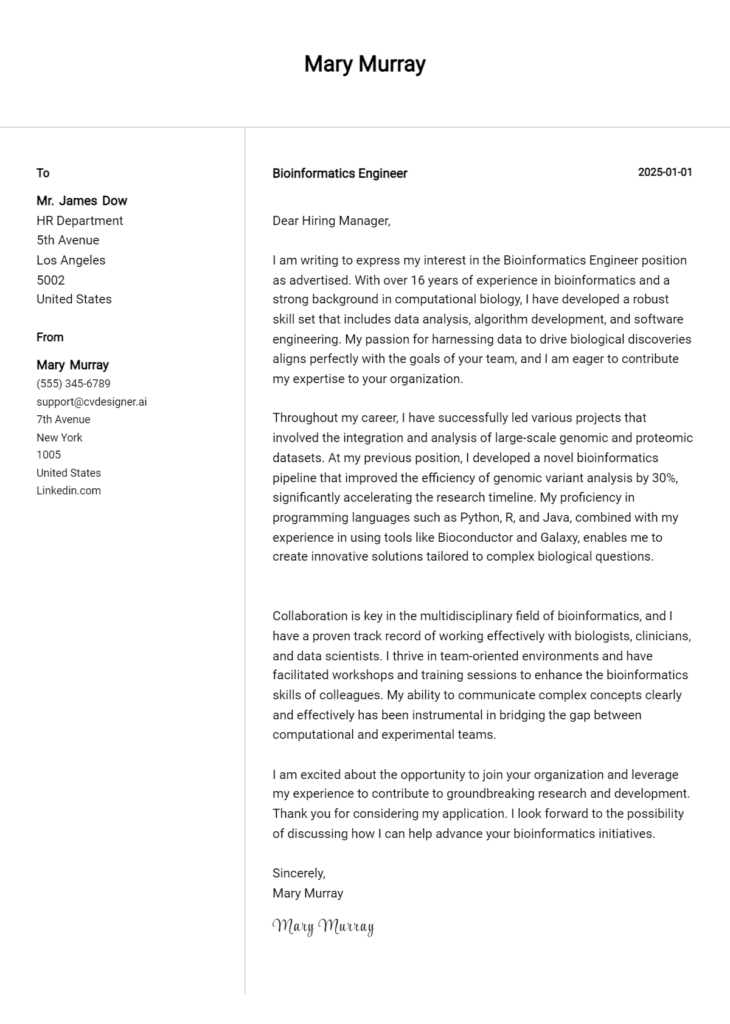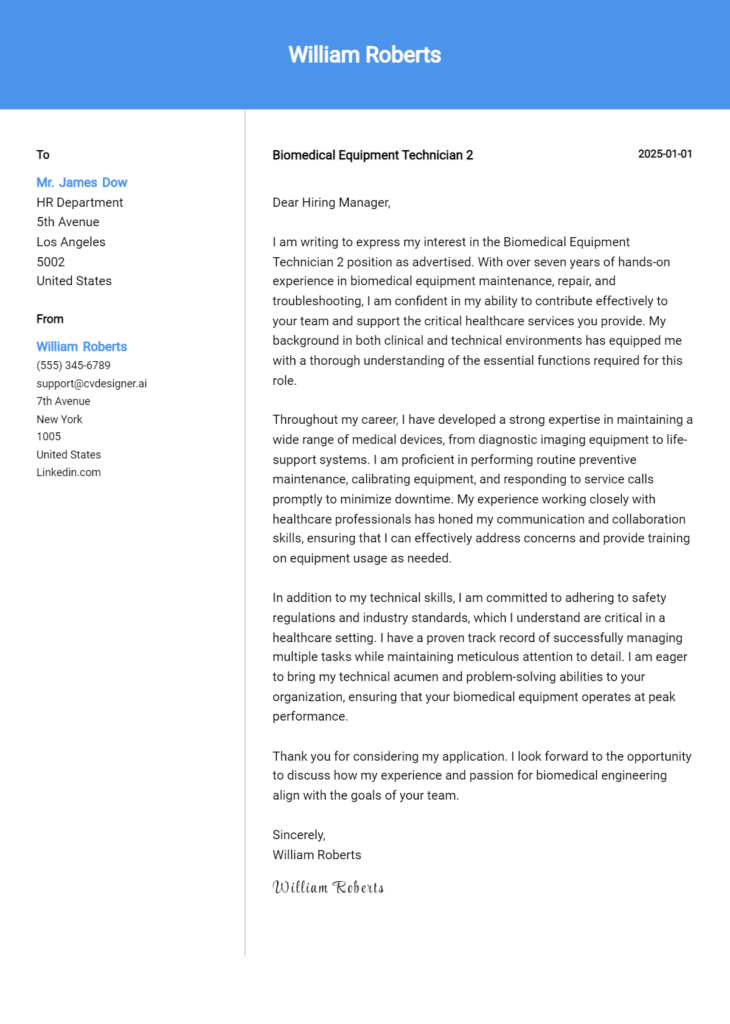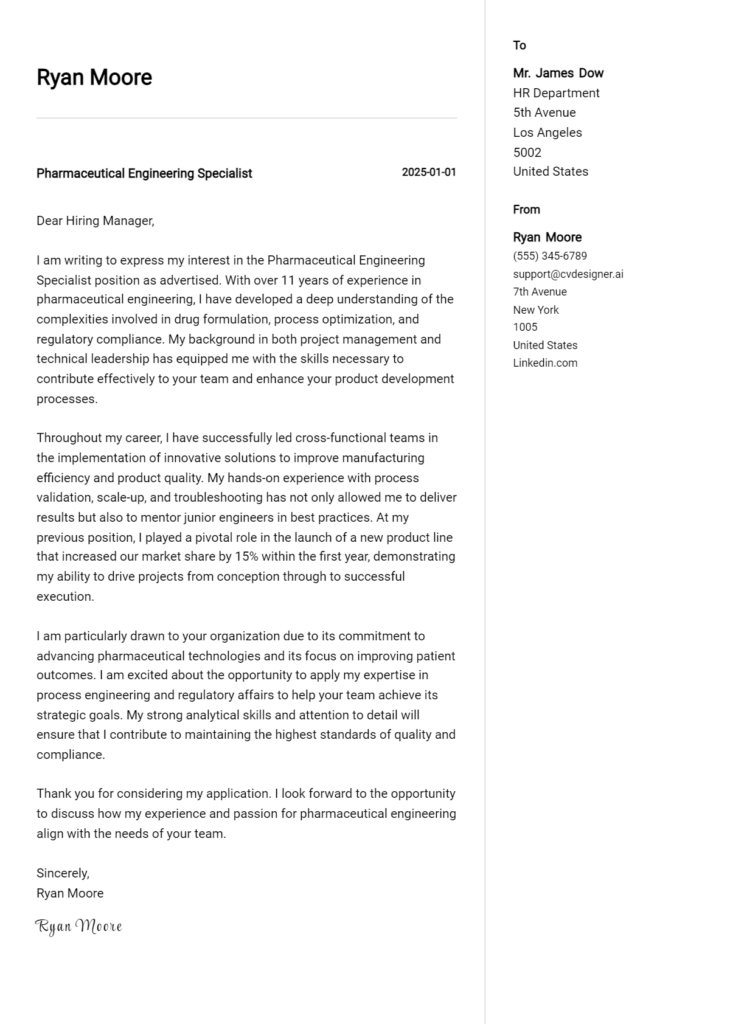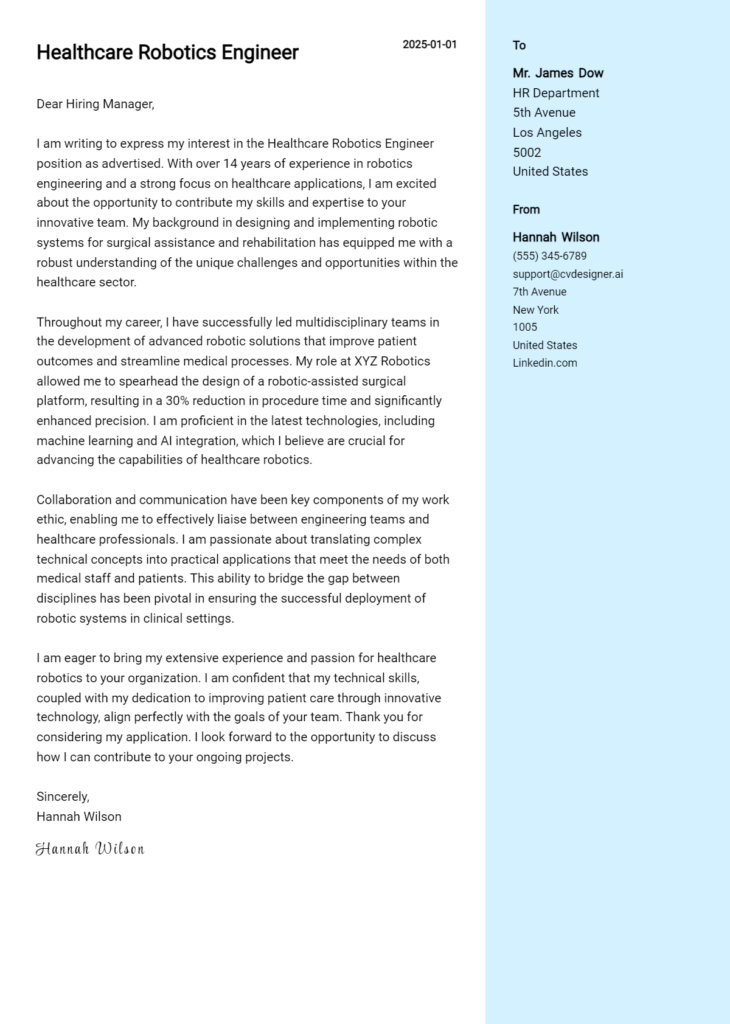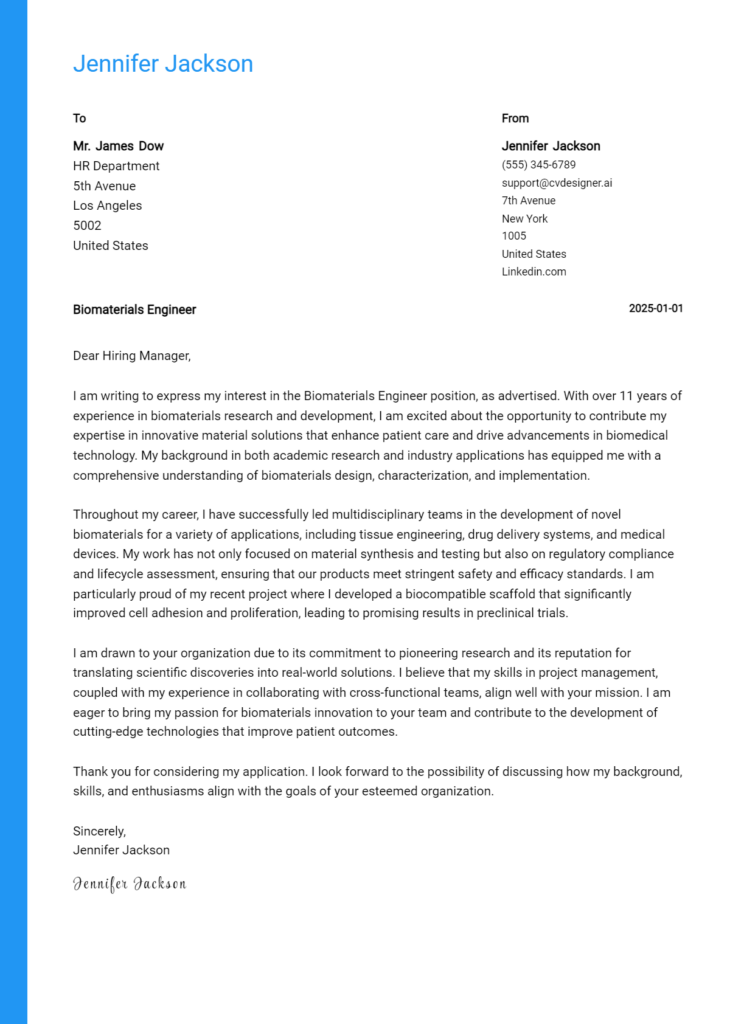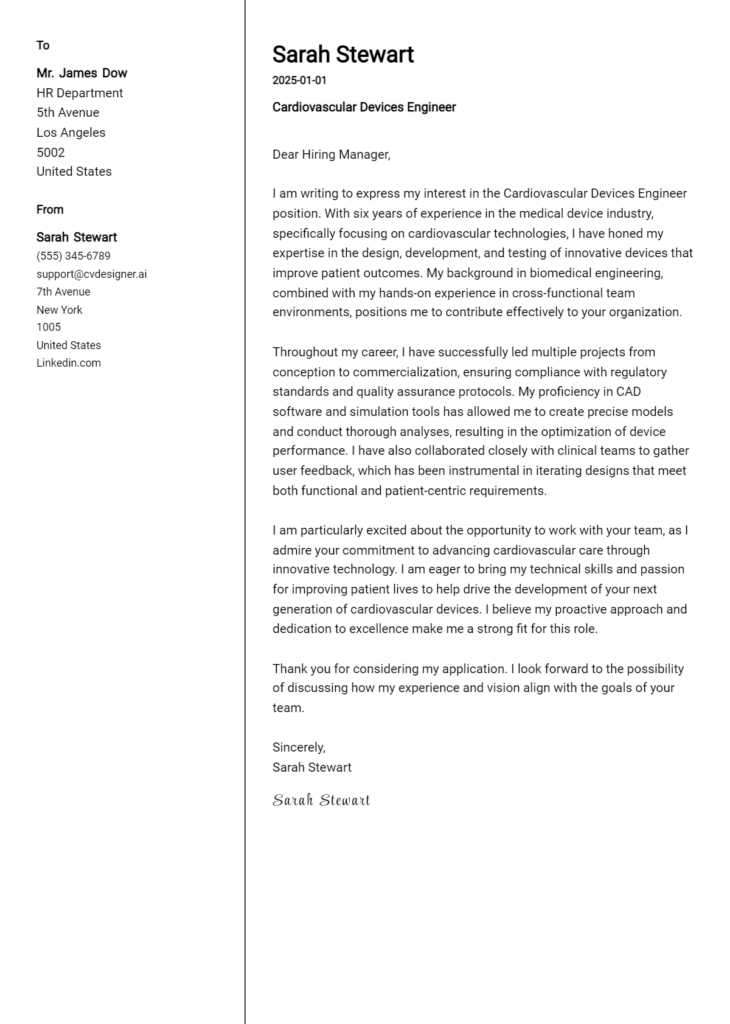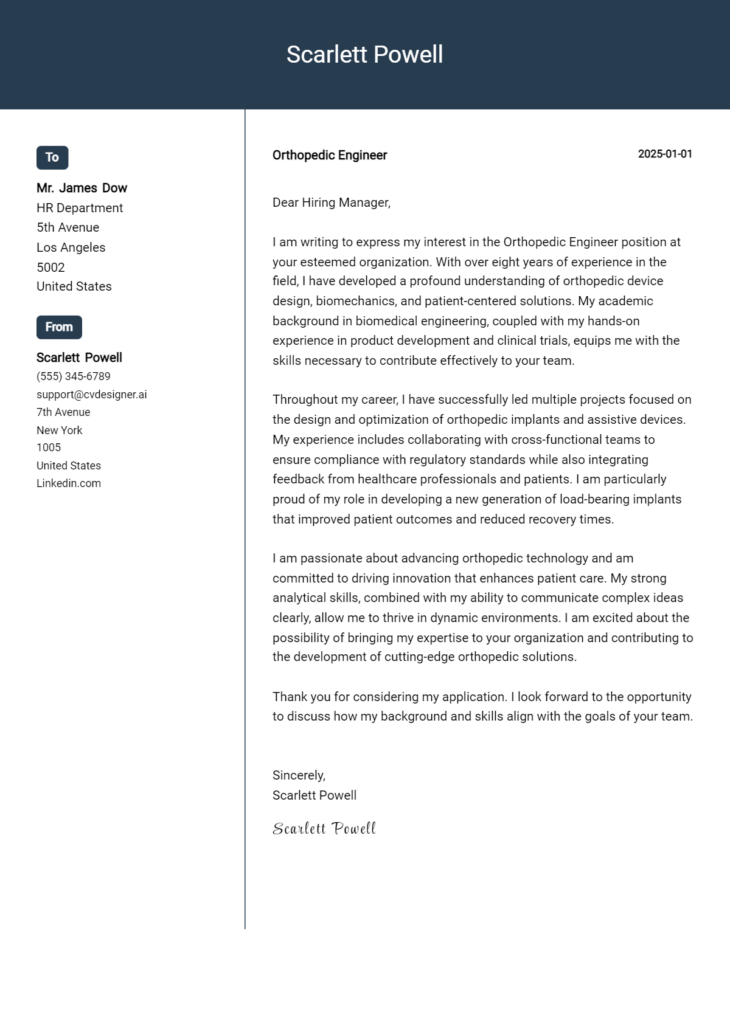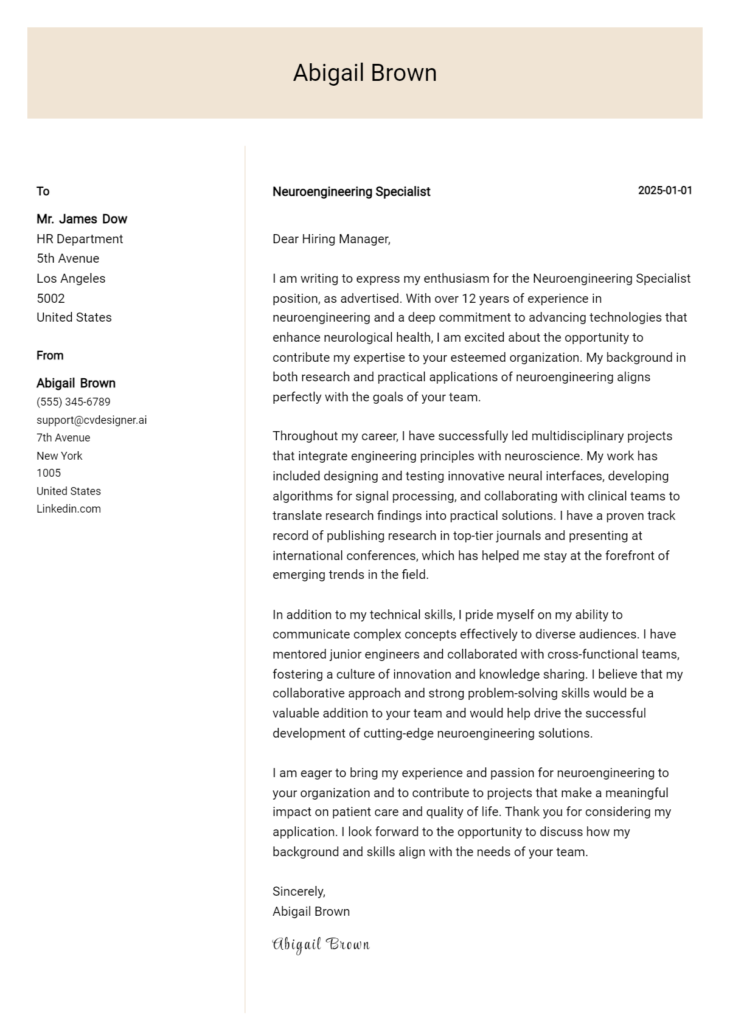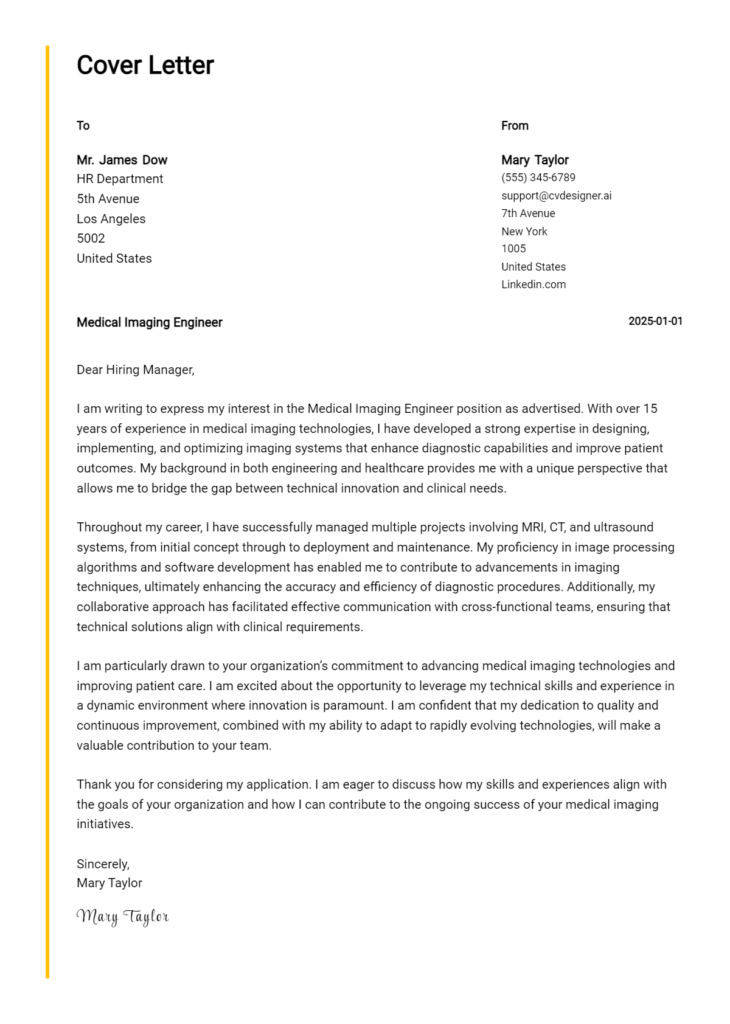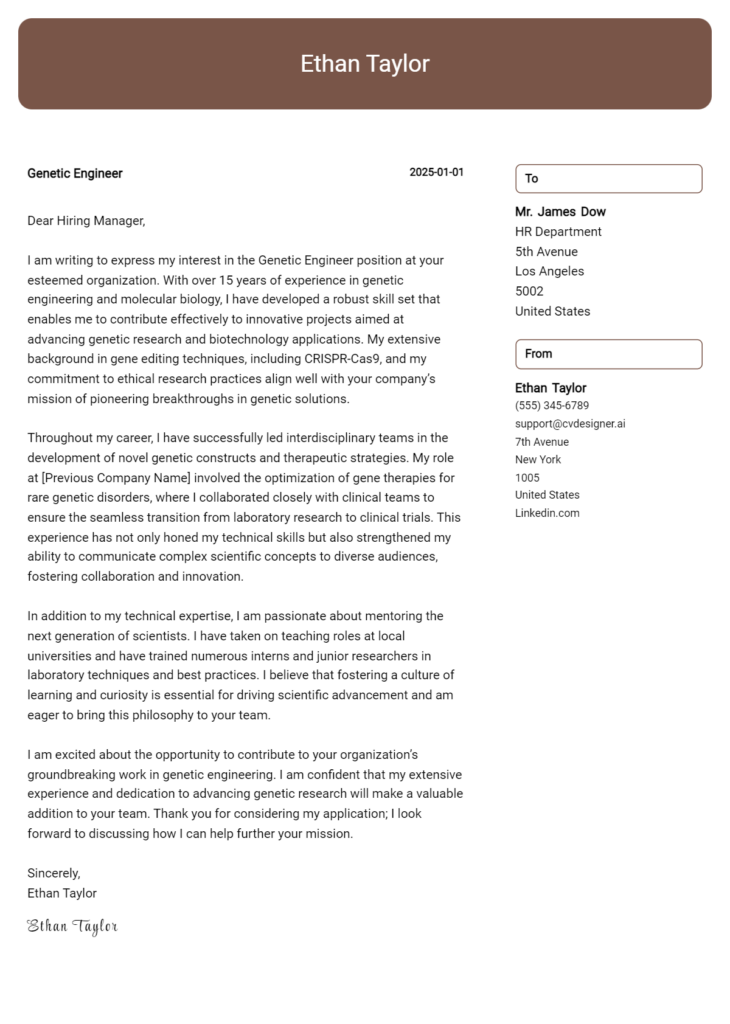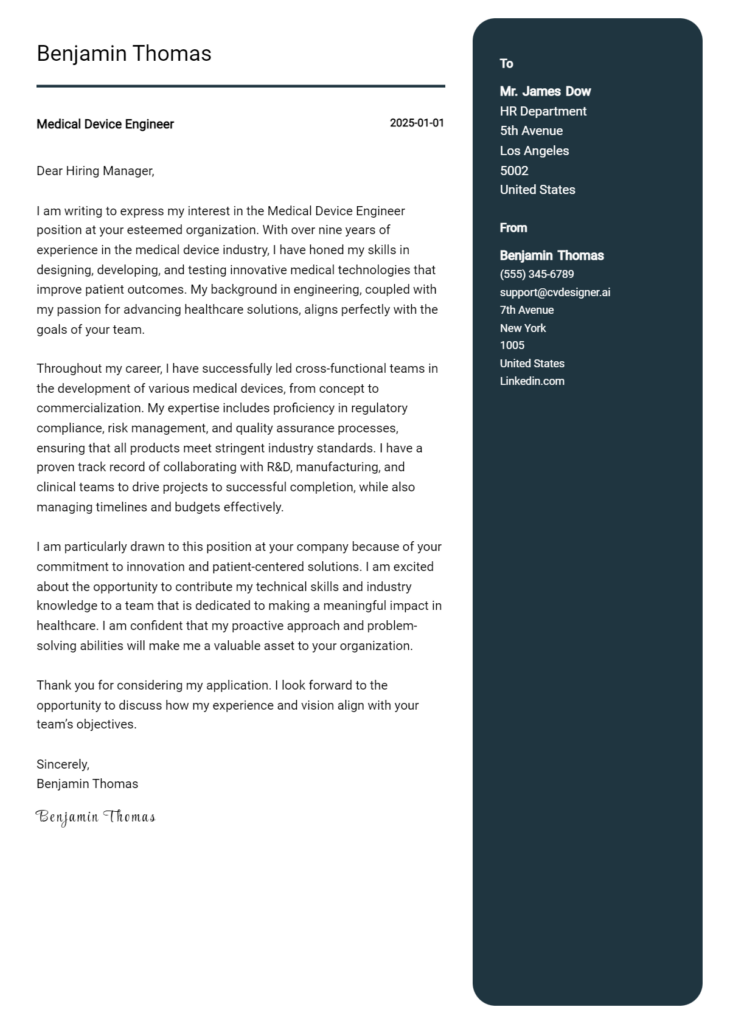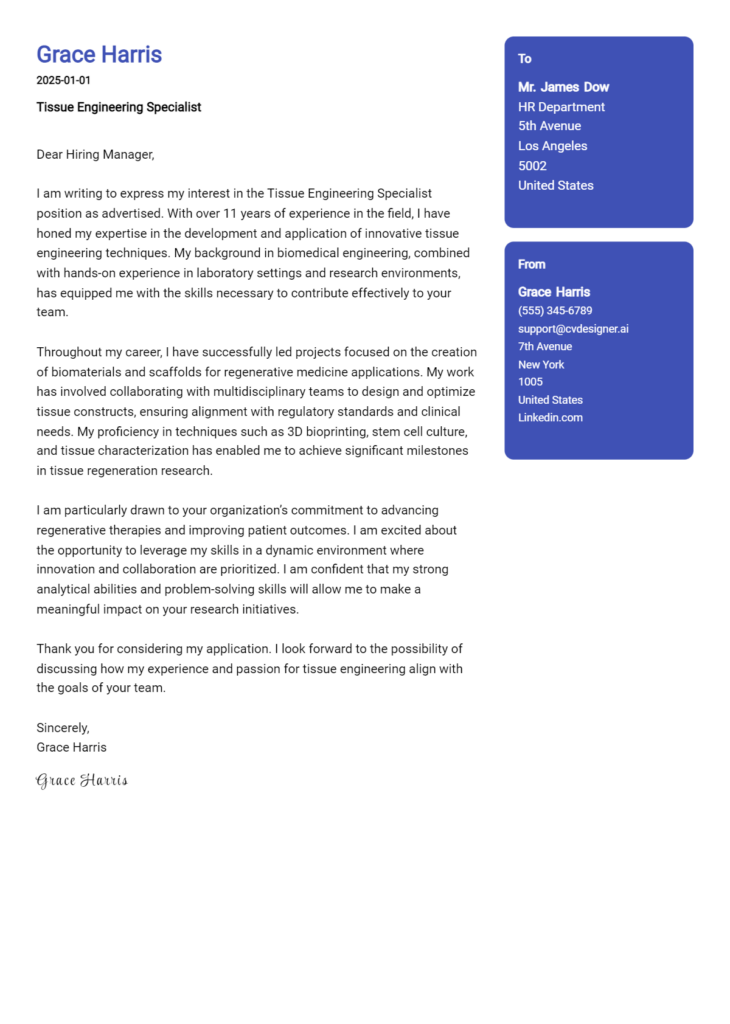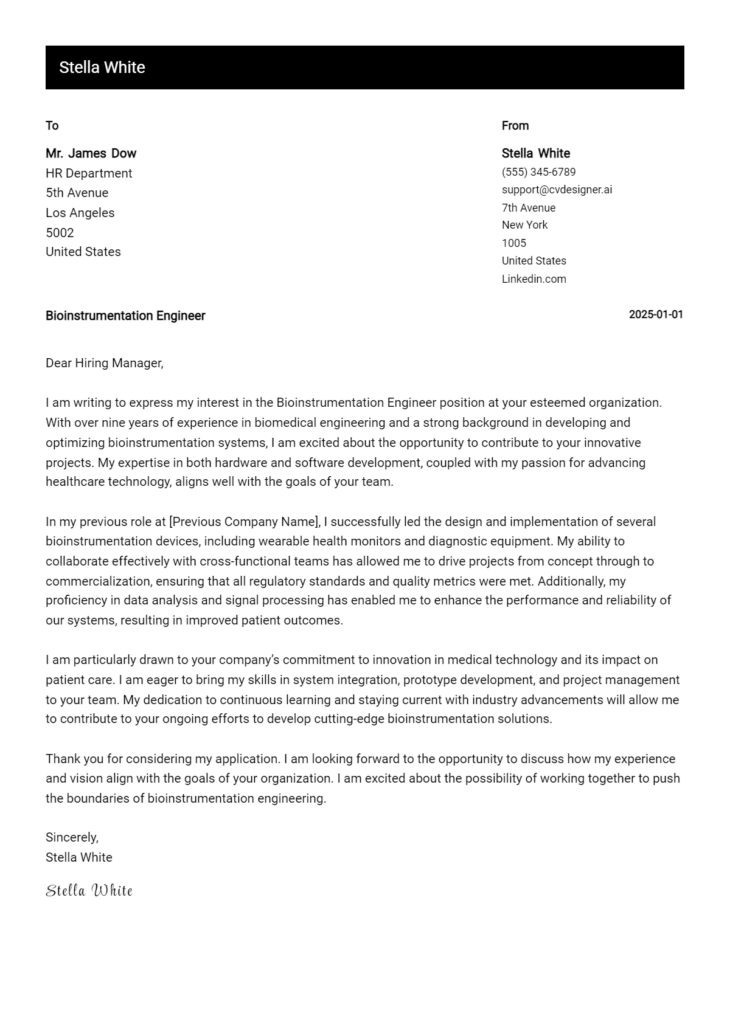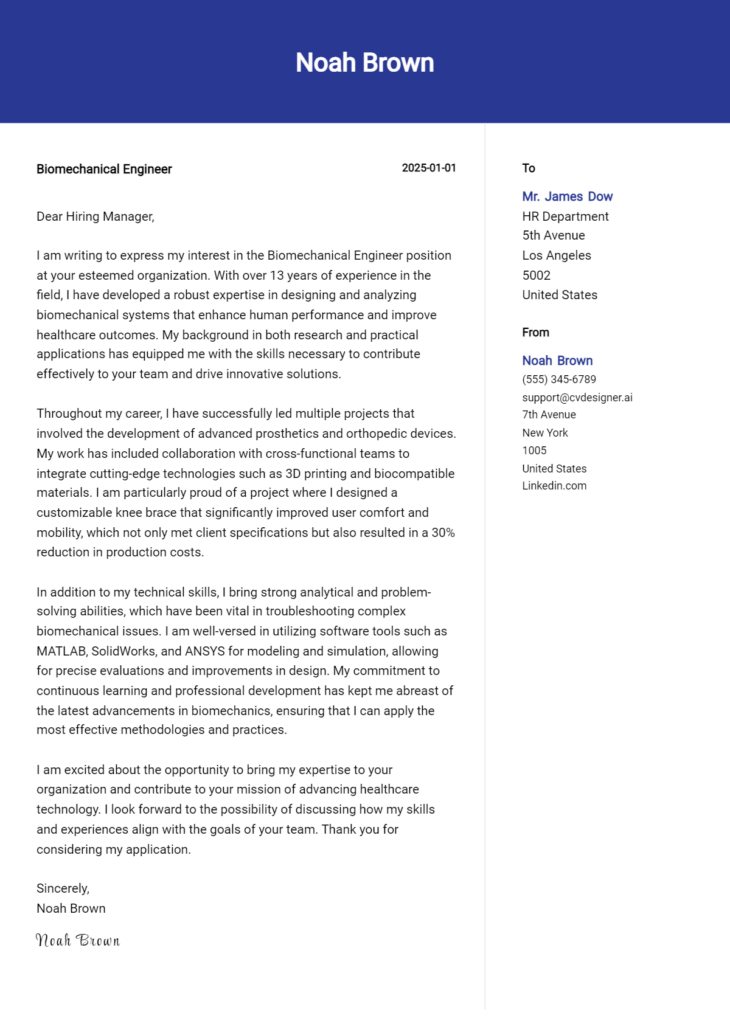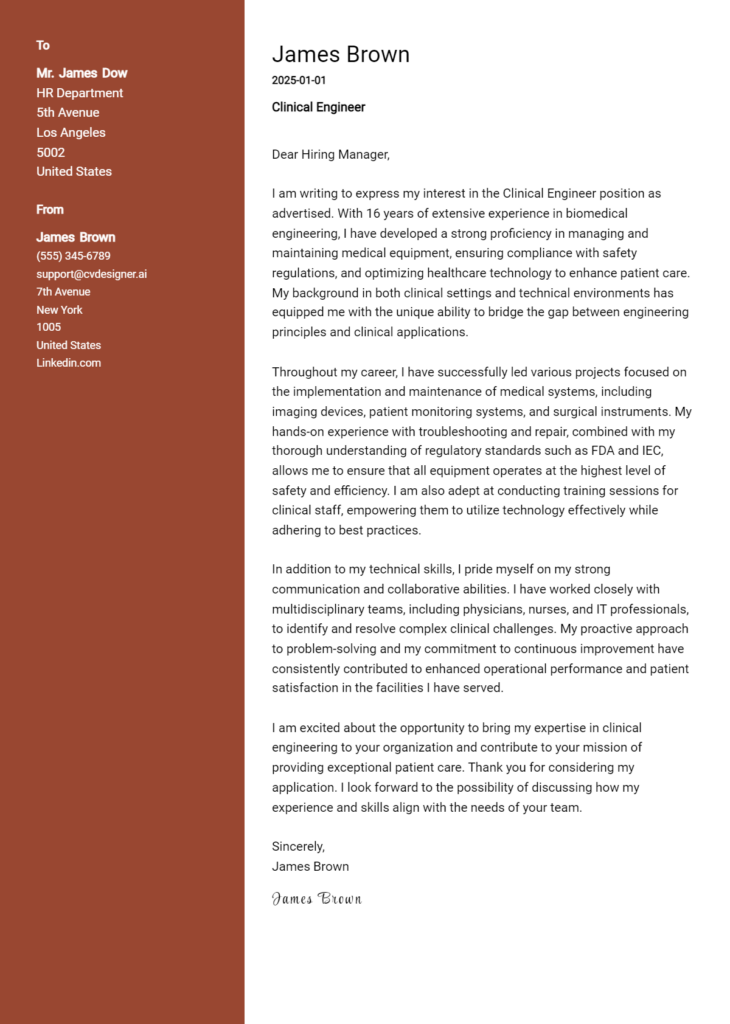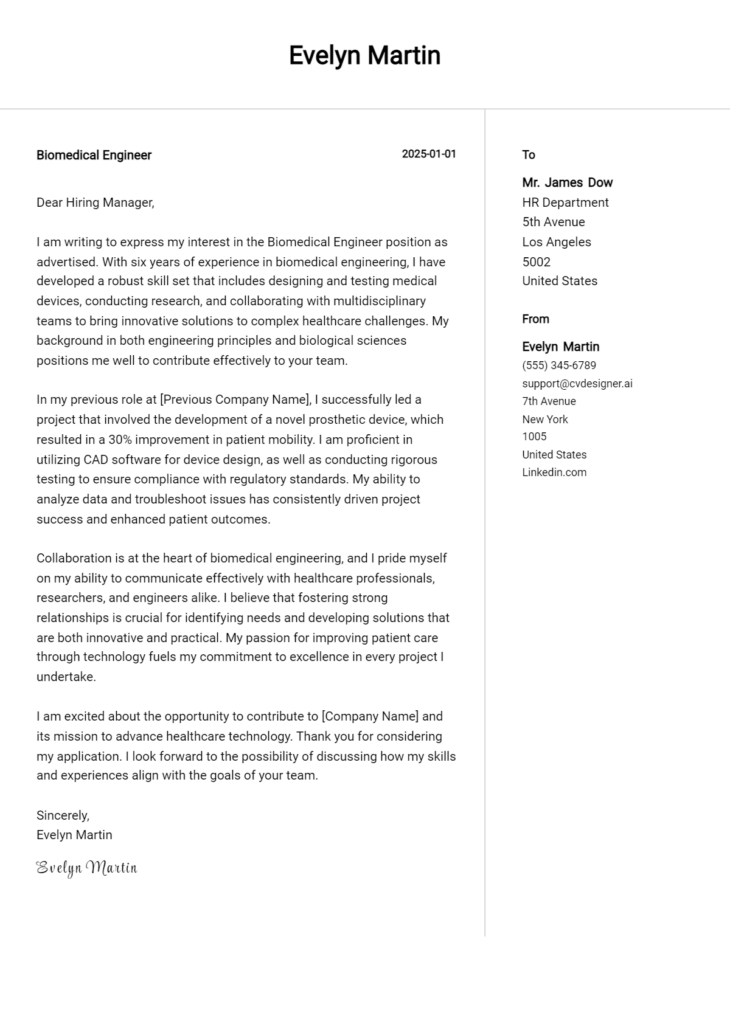Rehabilitation Engineer Cover Letter Examples
Explore additional Rehabilitation Engineer cover letter samples and guides and see what works for your level of experience or role.
How to Format a Rehabilitation Engineer Cover Letter?
Crafting a compelling cover letter for a Rehabilitation Engineer position is essential to convey not just your qualifications but also your understanding of how to improve the lives of individuals with disabilities. The format of your cover letter serves as a reflection of your technical skills and your innovative problem-solving abilities—both critical traits in this field. A well-structured cover letter can captivate the hiring manager's interest and demonstrate your commitment to enhancing mobility and accessibility for all.
In this guide, we’ll explore how to effectively format your cover letter, offering insights and specific examples relevant to the Rehabilitation Engineering profession.
We will focus on the essential components of a professional cover letter, including:
- Cover Letter Header
- Cover Letter Greeting
- Cover Letter Introduction
- Cover Letter Body
- Cover Letter Closing
Each section is pivotal in showcasing your qualifications and professionalism. Let’s break down each part and explain how to make your Rehabilitation Engineer cover letter shine.
Importance of the Cover Letter Header for a Rehabilitation Engineer
The cover letter header is a crucial element of your application as a Rehabilitation Engineer, as it sets the tone for your professionalism and attention to detail. A clear and well-organized header includes essential information such as your contact details, the date, and the recipient's information. This not only facilitates easy communication but also demonstrates your ability to present information in a structured manner, which is important in the field of rehabilitation engineering. A strong header reflects your commitment to clarity and professionalism, ensuring that the hiring manager quickly recognizes who you are and how to reach you.
Strong Example
John Doe 123 Main Street Springfield, IL 62701 (555) 123-4567 john.doe@email.com October 1, 2023 Jane Smith Hiring Manager Rehabilitation Engineering Solutions 456 Elm Street Springfield, IL 62702
Weak Example
John 123 Main St, Springfield 10/1/23 To Whom It May Concern
The Importance of a Strong Cover Letter Greeting
The greeting of your cover letter serves as the first impression you make on a potential employer, setting the tone for the rest of your letter. A well-crafted greeting can demonstrate professionalism and show that you have taken the time to personalize your application by addressing the hiring manager directly. Avoiding generic greetings like "To Whom It May Concern" is crucial; instead, make an effort to research the recipient's name and title, which can reflect your genuine interest in the position and the organization. Personalization not only enhances your professionalism but also helps you stand out in a competitive job market.
Tips:
- Use the hiring manager's name if you can find it.
- Avoid overly formal or vague greetings.
- If you're unsure of the name, consider using a title (e.g., "Hiring Manager") rather than a generic phrase.
Strong Greeting Example
Dear Dr. Smith,
Weak Greeting Example
To Whom It May Concern,
The Importance of a Compelling Cover Letter Introduction for a Rehabilitation Engineer
A well-crafted cover letter introduction is crucial for a Rehabilitation Engineer as it serves as the first impression to the hiring manager. This introductory paragraph should not only capture attention but also convey genuine interest in the role while highlighting key skills or achievements relevant to the position. A strong introduction sets the tone for the rest of the cover letter and encourages the reader to delve deeper into the applicant's qualifications. In contrast, a weak introduction may fail to connect with the hiring manager, resulting in a missed opportunity to showcase the candidate's potential contributions to the organization.
Strong Example
Dear [Hiring Manager's Name], I am excited to apply for the Rehabilitation Engineer position at [Company Name], where I can leverage my extensive background in assistive technology and biomechanics to enhance the quality of life for individuals with disabilities. With over five years of experience in designing innovative rehabilitation devices and a proven track record of successful project management, I am eager to contribute my skills and passion for improving patient outcomes to your esteemed team.
Weak Example
Dear Sir or Madam, I am writing this letter to apply for the Rehabilitation Engineer position. I have some experience in engineering and think I could do a good job. I hope you consider my application.
Cover Letter Body for a Rehabilitation Engineer
The purpose of the cover letter body for a Rehabilitation Engineer is to effectively communicate the candidate's unique qualifications, relevant experiences, and the potential value they bring to the prospective employer. This section should not only outline the candidate's technical skills and educational background but also provide concrete examples of past projects or accomplishments that demonstrate their competence in designing and implementing assistive technologies, improving patient outcomes, and collaborating with multidisciplinary teams. By highlighting specific achievements, such as the development of a customized prosthetic device that enhanced mobility for a patient, candidates can create a compelling narrative that showcases their passion for rehabilitation engineering and their commitment to improving the lives of individuals with disabilities.
Strong Example
In my previous role at XYZ Rehabilitation Center, I successfully led a project to develop an innovative adaptive device that improved the mobility of patients with lower limb disabilities. By collaborating with a team of healthcare professionals and utilizing advanced 3D printing technology, we created a custom prosthetic that not only met the functional needs of the patient but also provided a comfortable fit. This project resulted in a 30% increase in patient satisfaction scores related to mobility aids, demonstrating my ability to blend engineering expertise with patient-centered design. I am eager to bring this same dedication and innovative approach to your team at ABC Company.
Weak Example
I have worked as a Rehabilitation Engineer for a few years and have experience in various projects. I hope to bring my skills to your company. I know how to work with different types of equipment and have helped some patients. I am very passionate about my job and want to do well.
Importance of the Cover Letter Closing for a Rehabilitation Engineer
The closing paragraph of a cover letter is crucial as it encapsulates your qualifications, reiterates your enthusiasm for the role, and encourages the hiring manager to take the next step in the hiring process. For a Rehabilitation Engineer, this section should highlight your technical skills and passion for improving the quality of life for individuals with disabilities. A strong closing creates a lasting impression, while a weak one may leave your application feeling incomplete or unenthusiastic.
Strong Example
Thank you for considering my application for the Rehabilitation Engineer position. I am excited about the opportunity to bring my expertise in assistive technology and my passion for enhancing mobility solutions to your team. I believe my experience in developing innovative rehabilitation devices aligns perfectly with your company's mission. I look forward to the possibility of discussing my application further and am eager to contribute to your efforts in improving lives. Please feel free to review my attached resume, and I hope to schedule an interview soon.
Weak Example
So, that's it. I hope you think about my application. I guess you can look at my resume if you want. I would like to work at your company, but I’m not really sure what else to say. Maybe we can talk sometime?
Crafting an effective cover letter for a Rehabilitation Engineer position is crucial in showcasing your unique qualifications and passion for the field. This document not only provides an opportunity to highlight your technical skills and problem-solving abilities but also allows you to demonstrate your understanding of the Software Development Life Cycle (SDLC), your ability to work collaboratively within a team, and your commitment to continuous learning. The following tips will guide you in creating a compelling cover letter that stands out to potential employers.
Tips for Writing a Cover Letter for a Rehabilitation Engineer
Showcase Your Technical Skills
Begin your cover letter by emphasizing your technical skills relevant to rehabilitation engineering. Mention specific tools, software, and technologies you are proficient in, such as CAD software, assistive technology devices, or biomechanical analysis tools. Providing concrete examples of how you have applied these skills in previous roles will enhance your credibility.Highlight Problem-Solving Abilities
Rehabilitation engineers often encounter complex challenges that require innovative solutions. Use your cover letter to describe a specific situation where you successfully identified a problem and implemented a creative solution. This not only illustrates your problem-solving skills but also shows your ability to think critically and adapt to changing circumstances.Demonstrate Knowledge of SDLC
Understanding the Software Development Life Cycle is essential for engineers working on rehabilitation technologies. Briefly explain your familiarity with SDLC phases (requirements analysis, design, implementation, testing, and maintenance) and how you have applied this knowledge in past projects. This will reassure employers of your capability to contribute effectively to software development initiatives.Emphasize Teamwork and Collaboration
Rehabilitation engineering often involves working with a multidisciplinary team, including healthcare professionals, designers, and patients. Highlight your experience in collaborative projects, focusing on how you contributed to team success and improved patient outcomes. Mention any specific roles you took on within the team and the impact of your contributions.Express Passion for Continuous Learning
The field of rehabilitation engineering is constantly evolving, and a commitment to continuous learning is vital. In your cover letter, express your enthusiasm for professional development, mentioning any relevant courses, certifications, or conferences you have attended. This will demonstrate your proactive approach to staying updated with industry trends and innovations.
By following these tips, you can create a cover letter that effectively showcases your qualifications as a Rehabilitation Engineer. For additional resources, consider exploring our cover letter templates or using our cover letter builder to enhance your application further.
Common Mistakes to Avoid in a Rehabilitation Engineer Cover Letter
Crafting a compelling cover letter for a Rehabilitation Engineer position is essential for capturing the attention of hiring managers. Avoiding common mistakes can significantly enhance your chances of success. Here are some frequent pitfalls to watch out for:
Generic Language: Using a one-size-fits-all template can make your letter feel impersonal. Tailor your language and experience to match the specific job description.
Lack of Specific Examples: Failing to provide concrete examples of your achievements can weaken your application. Highlight specific projects or innovations that demonstrate your skills in rehabilitation engineering.
Ignoring Formatting Guidelines: Neglecting the proper cover letter format can make your letter difficult to read. Ensure your cover letter is well-structured, organized, and visually appealing.
Spelling and Grammar Errors: Typos and grammatical mistakes can create a negative impression. Always proofread your letter multiple times or use tools to help catch errors.
Not Researching the Employer: A lack of understanding of the company's mission and values may come off as uninterested. Research the organization to align your skills and experiences with their goals.
Overly Lengthy Content: An overly long cover letter can lose the reader's attention. Aim for a concise, focused letter that highlights your most relevant qualifications.
Failure to Include a Call to Action: Not inviting the employer to discuss your application further can leave your letter feeling incomplete. Conclude with a strong call to action that expresses your eagerness to discuss your fit for the role.
By steering clear of these common mistakes and referring to helpful cover letter examples, you can create a strong, effective cover letter that showcases your qualifications as a Rehabilitation Engineer.
Cover Letter FAQs for Rehabilitation Engineer
What should I include in my cover letter for a Rehabilitation Engineer position?
In your cover letter, emphasize your relevant education, experience, and skills that align with the Rehabilitation Engineer role. Start with a strong opening that introduces your passion for rehabilitation technology and your motivation for applying. Highlight specific experiences, such as projects involving adaptive equipment or collaboration with healthcare professionals. Discuss your technical skills, such as CAD software proficiency or knowledge of assistive devices, and how they relate to improving patient outcomes. Finally, convey your understanding of the company's mission and how you can contribute to their goals, showcasing your enthusiasm for the field.
How can I demonstrate my technical skills in my cover letter?
To effectively demonstrate your technical skills in your cover letter, use specific examples that highlight your expertise. Instead of simply listing skills, describe how you applied them in real-world scenarios. For instance, mention a project where you designed a custom prosthetic or developed a new rehabilitation device. Include metrics or outcomes to illustrate your contributions, such as improved patient mobility or satisfaction. Additionally, reference any relevant certifications or training that further validate your technical abilities. This approach not only showcases your skills but also illustrates your practical experience in the field of rehabilitation engineering.
How long should my cover letter be?
Your cover letter should ideally be one page long, with a length of approximately 300 to 400 words. This length allows you to concisely present your qualifications while maintaining the attention of the hiring manager. Focus on clarity and brevity; each paragraph should serve a distinct purpose—introducing yourself, detailing your relevant experience, and concluding with a strong closing statement. Avoid lengthy explanations or unnecessary jargon. Instead, prioritize impactful statements that align with the job description. Remember, the goal is to entice the employer to learn more about you through your resume and ultimately secure an interview.
Should I customize my cover letter for each job application?
Absolutely! Customizing your cover letter for each job application is crucial in showcasing your genuine interest in the specific position. Tailoring your letter allows you to align your skills and experiences with the job requirements, demonstrating that you have researched the company and understand its needs. Use keywords from the job description to highlight your qualifications and match them with the company’s values and goals. Personalizing your cover letter not only makes it more relevant but also sets you apart from candidates who submit generic applications. This effort shows your commitment and enthusiasm, increasing your chances of standing out in the hiring process.
Build your Cover Letter in minutes
Use an AI-powered cover letter builder and have your letter done in 5 minutes. Just select your template and our software will guide you through the process.

